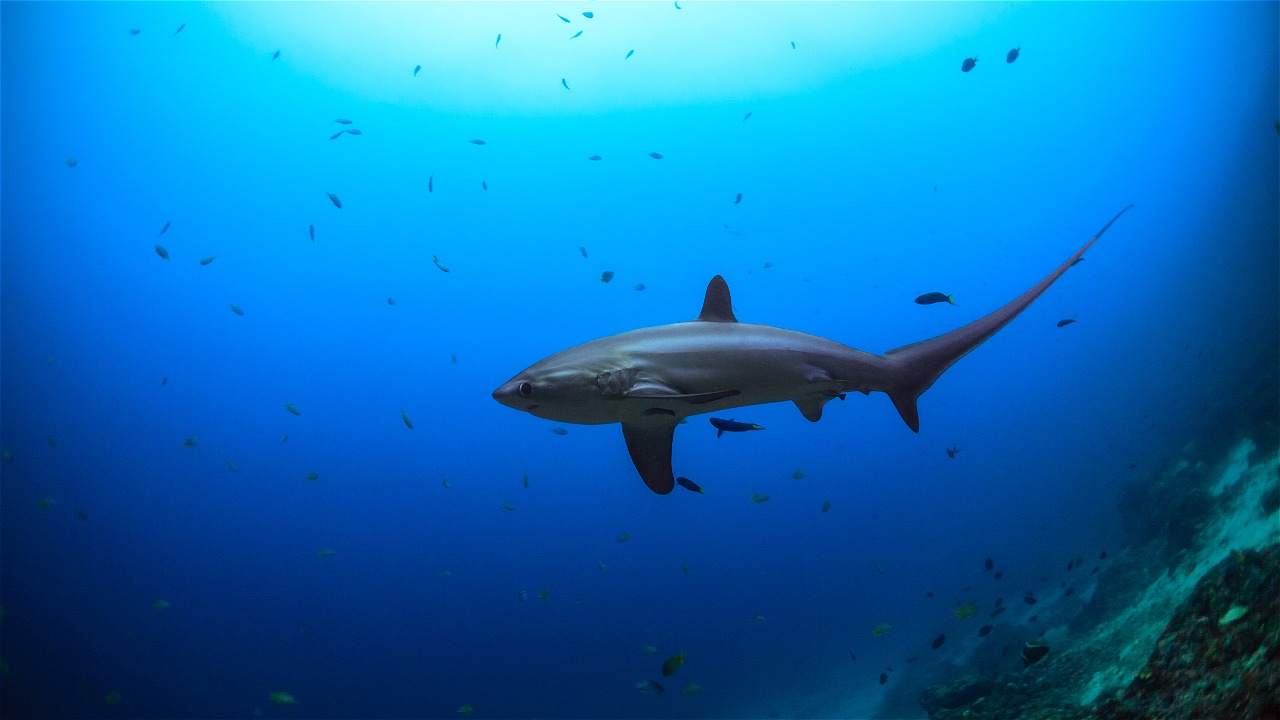THE FIGHT TO SAVE THE THRESHER SHARK
I first saw a thresher shark in 2003, 30 meters deep in the Visayan Sea, as night turned to day, writes Andy Cornish, WWF Global Shark Leader.
An hour earlier, my wife and I were on an outrigger boat with several divers off Malapascua Island in the central Philippines. We were sailing under the stars toward Monad Shoal. This vast area of coral reef is known as the only place in the world where you can see thresher sharks without having to dive too deep.
Here these pelagic rat sharks generally rise from the depths after dawn, along with other fish at cleaning stations along the reef. It was a chilly sea to dive in, but the chill was worth it at least when we rounded the cleaning station and saw a grayish-blue shadow, slowly surfacing. Suddenly, our dive master called out and directed us to a three-meter rat shark - very obvious with its crescent-shaped tail - passing in front of us.
It's a moment we'll never forget - especially when we learn that the shark population has declined by more than 70% in the areas where they're found. They now need global protection from around the world.
Twenty minutes later, we see more rat sharks circling the post for cleaning, looking like the shadow of an airplane. A few passed right above us as if ready to pose while I set up my camera exposure in the dark. The pictures I got were of poor quality due to the strict ban on using flash on cameras as it can disturb and startle them. However, the experience of diving with sharks was enough to make us reluctant to return to the surface.
I have since visited Malapascua twice, most recently a few months ago. WWF, the Manta Trust and Project AWARE worked together to develop a shark and ray tourism guide. We used the mouse shark dive area in Malapascua as a successful case study.
The pelagic rat shark is one of three species of rat sharks; a type of shark whose primary diet is small fish at a depth limit of a few hundred meters. While it was already widely known that the thresher shark hunts fish with its whip-shaped tail, scientific proof only came in 2010 when experts filmed a pelagic shark hunting sardines. Through the slow-motion footage, it can be seen that the rat shark uses its tail to strike from the sides and even from above to immobilize schools of fish.
Unfortunately, this predatory fish is the most threatened of all pelagic sharks. The depths inhabited by Pelagic thresher shark, Big eye thresher shark and Common thresher shark are crowded fishing areas. These sharks are often caught in offshore longlines and other pelagic gillnets, some of which target sharks, while others are used to catch tuna and other species. This kind of fishing - and some other fishing methods such as those using gillnets in offshore reef areas - is largely unregulated and not recorded or reported. A painful incident occurred when I visited the Port of Karachi in Pakistan a few months ago, and once again saw rat sharks. But by then the rat sharks I encountered were already lifeless on the docks, caught in the gill nets of irresponsible fishermen.
This unsustainable fishing is accompanied by a lack of conservation efforts in most of their areas and low reproductive rates - for example, the bigeye thresher shark can only give birth to less than 20 pups in its lifetime. This leaves them living under the threat of extinction.
However, better protection measures are being formulated. As a result of the increasing attention to the endangerment of the thresher shark, Sri Lanka has proposed that all three species be included in Appendix II of the Convention on International Trade in Endangered Species of Wild Fauna and Flora (CITES), which would regulate the global trade in thresher shark products - with the restriction that fishing is only for sustainable fisheries. This is important as many shark fins are exported to Asian countries for shark fin soup, which is highly prized.
Sri Lanka's proposal was well received and to date, 22 countries plus the European Union have expressed their official support. The final decision for the thresher shark - along with the silky shark and devil ray, which are also proposed for Appendix II - will be made by 182 parties at the CITES meeting in South Africa, to be held in September.
WWF and TRAFFIC strongly support all of these proposals. We will be campaigning and speaking out for this proposal to be accepted along with other partners in the Global Shark and Ray Initiative over the coming months. It won't be easy, as some countries have rejected this proposal, but we were successful in getting some shark and ray species included in CITES in 2013. We will try hard again.
Hopefully, many countries will support us at the CITES conference and help sharks and rays - so that later when I see a thresher shark, I know that we have taken a big step to save them.
Source:
http://wwf.panda.org/wwf_news/?273230/Battle-to-save-the-threshers





